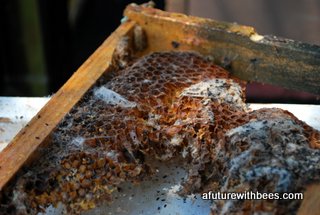Watch the video and view the picture gallery below to better understand Lesser Wax Moths in Missouri. Jeff describes and show you the impacts of pests on weak or dying colonies. The lesser wax moth typically resides in milder climates, but can be prevalent in areas such as Florida because of the year-round warm climate. These moths live around 7 months, from egg to senile adult. They go through four stages in their life cycle – egg, larva (caterpillar), pupa and imago – like all holometabolous insects.

Populations of these moths take over the honeycombs of bee colonies, usually when the bees are in a weakened state. Lesser Wax Moths can often be seen in bee colonies trying to lay their eggs, but in most cases the worker bees will eliminate them and keep the moths from over-running the colony. When the colony is going through a period of stress, such as after the loss of its queen bee or under starvation conditions, the moths may completely take over the honeycombs.
The bees themselves are the best form of control for these moths. They keep the populations at very low numbers and it is only 
Click Image to see the Gallery


